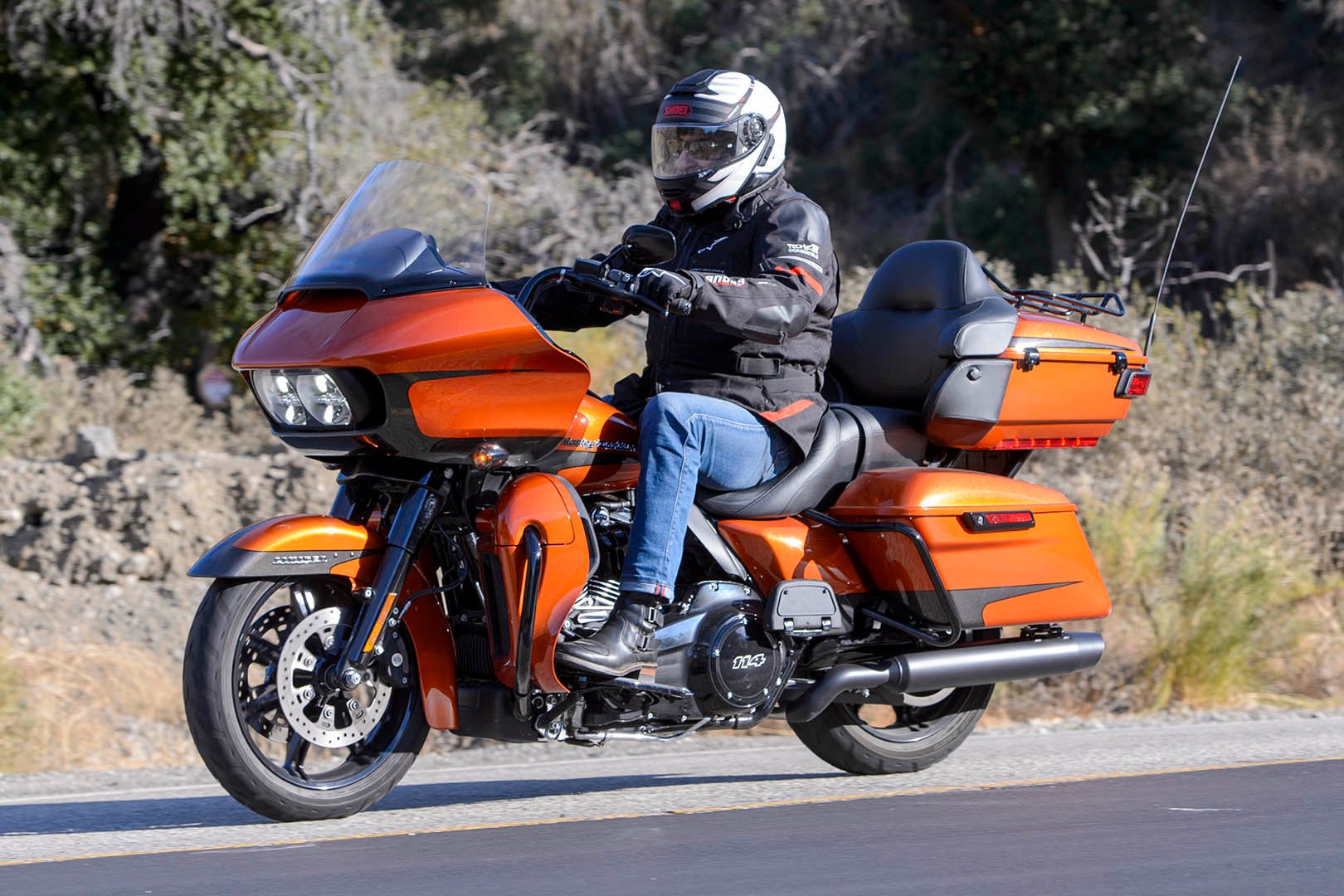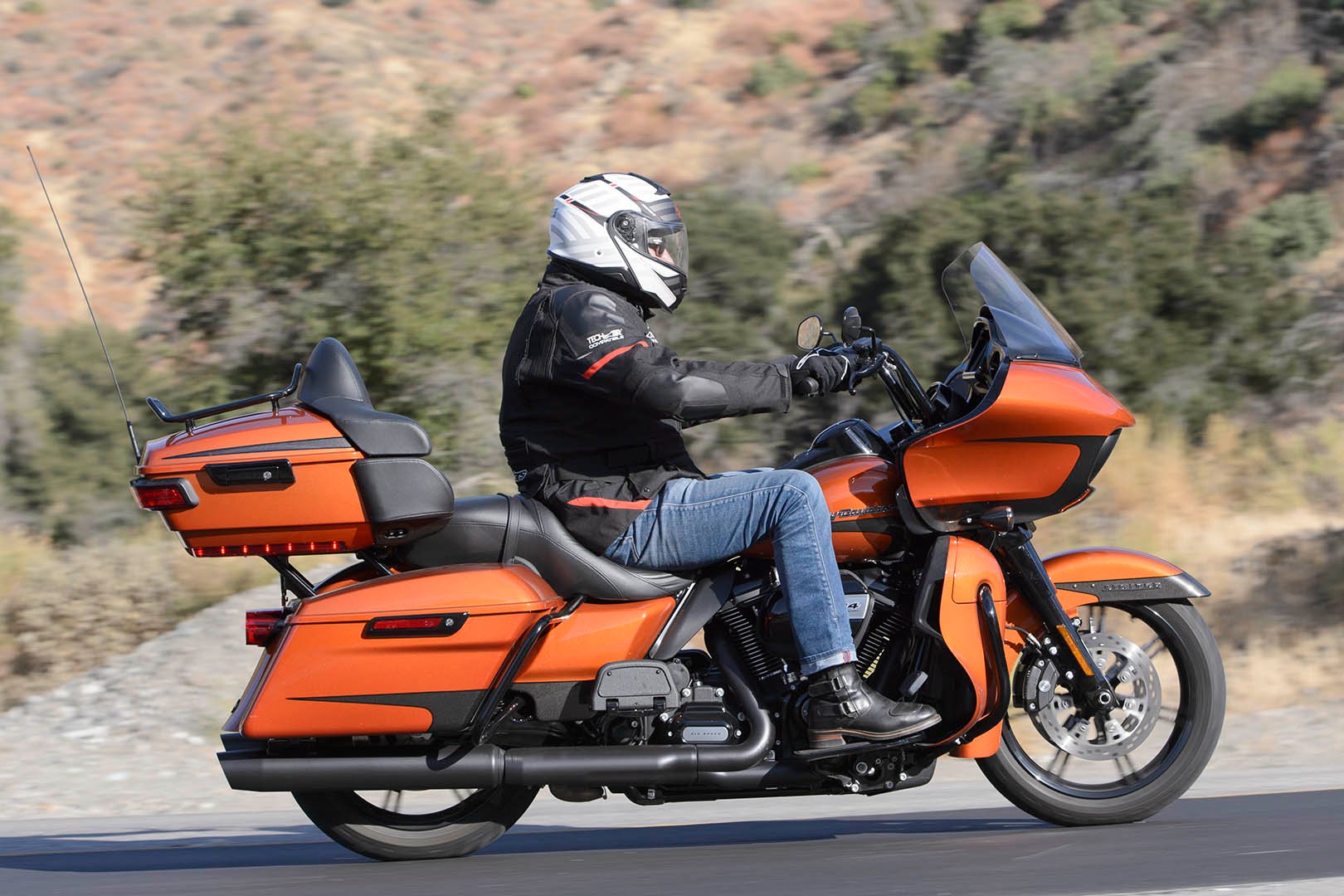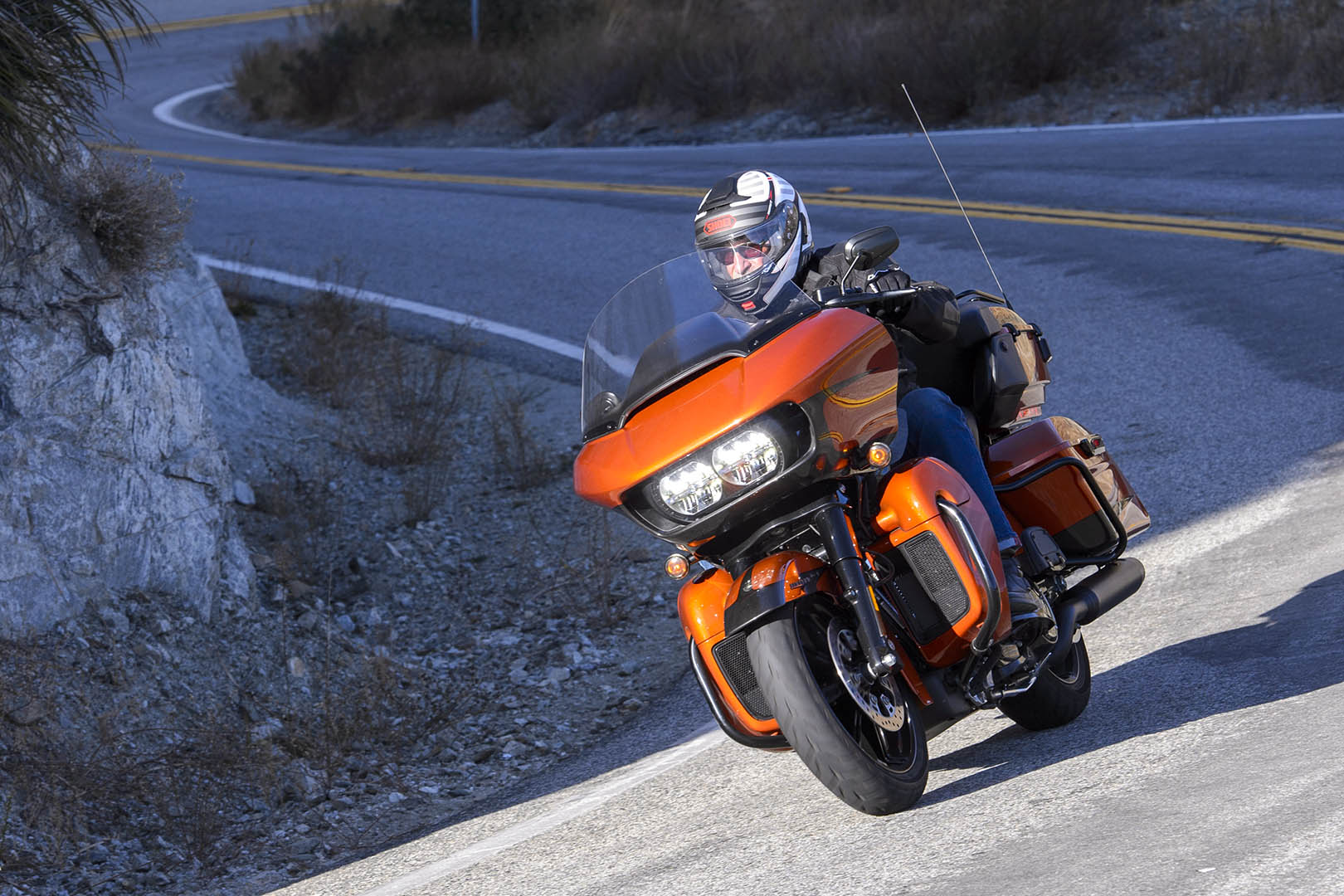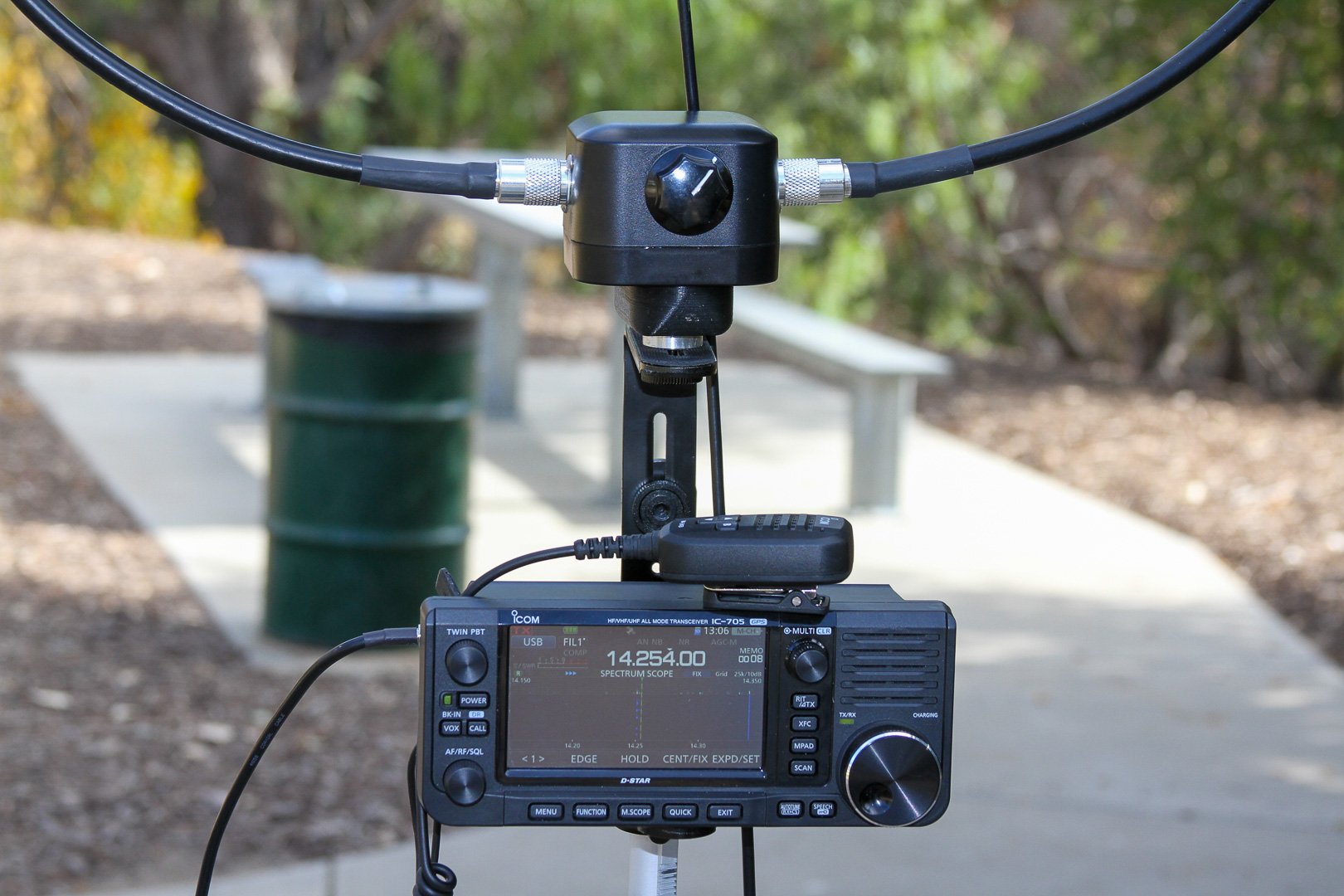I needed to borrow a Harley—any Harley. It’s mandatory for the ongoing theme of my Ham on a Hog series of ham radio/moto adventures. I’ll admit I’m a bit of a nerd and, statistically speaking, you probably have no interest in amateur radio nor any idea why anyone would. Be that as it may, Harley-Davidson loaned me an eye-popping Road Glide Limited. That bike sure upped my interest in the moto side of the review and deserves some attention.
FIRST IMPRESSIONS: 2020 Harley-Davidson Road Glide Limited
It’s big, really big. Harley claims the Road Glide Limited weighs in at 932 pounds “in running order.” The gift this weight brings is an amazing ride once underway, though a smaller rider may have to struggle a bit to get it off the sidestand.
The Road Glide Limited is remarkably stable and agile within its self-proclaimed environment. This motorcycle lets you know right away that, to use its strengths, one must fully adapt to its needs. I found one need is to be mindful of any sudden changes. Another is to make full stops. Oh, and not presume to be able to make radical changes at low speeds.
Maneuvering at slow speeds requires experience and finesse. I never had any “exciting moments” because I respected its size and requirements. I rode the bike lightly loaded, and it was a handful when the speedometer needle was on the left side of the dial. I imagine the pilot who rides one two-up with full panniers will need every bit of his skill to keep things right-side-up.
But then it finds its way to the freeway or smooth, undulating two-lane, like Casitas Pass Road (California State Route 150) from Ojai to Rincon State Beach in Carpinteria. This is where the Road Glide shines. Long vistas leading to fast sweepers make you feel like you never want to stop, and the 200+ mile range allows one to imagine that the road goes on forever.
Crack open the throttle on a freeway or open road, and the Twin-Cooled Milwaukee-Eight 114’s 122 ft-lbs of torque at 3000 rpm will tug pretty hard on your arms. The chassis remained stable through any of my requests, thanks to the geometry and the Showa suspension.
Easy transitions of direction are no problem on two lanes at 75-80 mph. The electronically linked Brembo brakes worked splendidly as I followed my sportbike pals through the hills. The nicely implemented cruise control made dreamy work of freeways and, at 95, the Glide was stable and asking for more. Torquey, powerful, fast, smooth, great sounding, poised, and taut—a magic carpet ride.
Approaching the motorcycle for the initial time shows the build quality of every component. The closer one examines the details, the more appreciation one can generate for every facet of the build. UM Editor Don Williams, in his Road Glide Limited review, writes, “The 2020 Limited gets a higher level of paint with pinstriping, a glossy finish for the fairing interior (which the rider is always looking at), heated grips, Slicer II Contrast Bright wheels, and new medallions on the fuel tank and front fender.”
The paint is the optional Scorched Orange color with Black finish (add about $4100) and is like a perfect nail polish job. There are no imperfections, orange peel, or other elements that might detract—it’s almost CVO quality. A close inspection of all the componentry reveals the same quality, which, in my view, is as good or better than any other manufacturer’s offerings.
I enjoyed the full-color TFT touchscreen, which is pretty easy to use and has all the information I need. It is robust and includes every feature you might want. Although I didn’t have time to immerse myself in all its functionality, I figured out what I wanted without reading a manual—being a ham guy helps, no doubt.
The top case and panniers have a combined 47 cubic feet of cargo space, are easy to operate, better than most brands, and their one-touch locking mechanisms open and close with a whisper. The Tour-Pak swallowed up everything I was bringing on my expedition, with room to spare.
The seat is super comfy and fits my size (6 feet) just about right. I need to ride at the back of the saddle; if you’re taller than me, you might be a candidate for some seatwork.
I’m not a big fan of the handlebar’s bend, yet that’s a small matter. I found that to grasp the round grips squarely, I needed to keep my elbows in, or I could hold them at a slight angle to accommodate my own geometry. I chose the latter and never gave it another thought.
The motorcycle looks great and is super impressive. At gas stops populated with riders, this Glide got a lot of attention. When passing other Harley riders, it was the star of the show.
AMATEUR (HAM) RADIO: Icom and More
Now that I’ve gotten my Ham on a Hog 3 ride squared away, let’s talk a bit about how amateur (ham) radio fits in with motorcycles or with people, in general. For this story, I won’t go into as much detail as I did in my in-depth online review of the new Icom IC-705 radio transceiver, but it’s there if the ham radio world sounds enticing.
I got into radio communications as an early teen. I can’t remember my motivation, but I thought it was pretty cool back then in the pre-transistor days of vacuum tubes and crystals. There’s just something about it that intrigued me, as it does the over 770,000 licensed radio amateurs in the US.
How many times have I heard someone ask me why I would be interested in a 100+ years old communication method when we all have smartphones in our pockets? Too many, and they just don’t get it. Just like your friends who ask why you ride a bike? Why you take the risk? Why you battle the elements? Why you eat bugs? Why do you bother when you can comfortably drive a car? They just don’t get it.
Here’s why I do ham radio. I can communicate with other people when all other methods cave in. Too far from a cell tower. No problem. Finding out what’s going on during a time of emergency when all other means fail. No problem. Sharing, communicating, and coordinating whatever is needed during times of trouble, not unlike what some are envisioning during these crazy political and pandemic times. No problem.
Speaking of the pandemic, many of us are at home more often than we’d like to be. Amateur radio is a perfect way to meet and get to know new people in faraway places, trade stories and updates, and be a bit more sociable at a time when that’s much harder.
In 2018, during my evacuation from the Woolsey Fire here in SoCal, my little handheld radio was able to reach a repeater nearby when I had no news of what was happening. I connected with another ham who gave me directions on how to get home by skirting closed roads—not lifesaving but undoubtedly important at the time.
When everything is rosy, a ham might pursue contacting people around town, across state lines, across the country, or around the world just for the sake of chatting with people in different places, in different ways, and honing their radio skills at the same time.
Speaking of skills, there are dozens of methods and modes of communicating nowadays, especially with computers and the Internet added into the mix. It may have started with Hiram Percy Maxim (1869-1936), an American radio pioneer and inventor, and co-founder of the American Radio Relay League (ARRL), America’s national association for amateur radio. Back then, one basically operated in CW (continuous wave – Morse code) mode only.
Now hams operate in the radio spectrum, from below AM broadcast frequencies into the gigahertz range. While some still use CW, voice modes and digital are most popular. Modes such as AM, FM, and SSB (single sideband) have grown to now include digital voice, as well as digital modes with which the computer operates the radio as programmed by the ham. With digital modes transmission, range is improved dramatically.
Some bounce signals off the moon (EME: Earth-Moon-Earth) to reach stations over the horizon. Others use VHF/UHF signals to talk with astronauts on the ISS space station and receive digitized photos. Others have huge antenna arrays and powerful signal amplifiers. Some enjoy the challenge of QRP radio, which uses an output of no more than 10 watts to contact people far and wide. Some do amateur television, and others operate with and through repeaters.
Repeaters, generally, are powerful receiver/transmitter combinations that are located in advantageous spots, such as mountain tops, and often cover substantial geographical areas. They receive a signal and instantly rebroadcast it. That enables someone (like me with a modest handheld) to talk with another person through the boosted signal of the repeater when we otherwise would not be able to speak directly to one another (simplex mode) due to being out of range.
Now many repeaters are tied together via both radio and the Internet, enabling massive repeater networks. This allows hams to connect to repeaters in other countries. The system can track down a user and switch to the proper repeater. One might talk to a pal almost anywhere, or show his location on a map through the radio’s built-in GPS, Bluetooth, and WiFi.
Icom of Japan is one of the largest manufacturers of amateur radios, plus communications devices for commercial, maritime, satellite mobile, and aircraft. Icom operates in the US as Icom America, and its line of ham radios is, arguably, the broadest and most modern of the prominent manufacturers.
Icom recently introduced the much-heralded IC-705 All Mode Portable. It is a QRP radio that incorporates more features and modes in a 2.4-pound form factor than any other radio I can think of. It’s perfect for my penchant for taking a radio somewhere in the boonies, along with a lunch or camping gear, and having some fun. It was the ideal candidate for Ham on a Hog 3.
I’ve kept most of the IC-705’s details for my Ham On A Hog 3 story, so I’ve stuck to the basics here. My hope is that, if you’re a ham, my stories will entice you to take a radio for a ride. If you’re not a ham, my stories might just give you the itch to learn more.
Want to learn more about amateur radio? Groups and information are all over social media, YouTube, and myriads of hobbyist websites. Start with the ARRL, and you can get licensed and on the air in no time.
Photography by Jonathan Handler and Don Williams
RIDING STYLE
- Helmet: Shoei Neotec II
- Jacket: Alpinestars Andes Pro Drystar w/ Tech-Air Street airbag system
- Gloves: Alpinestars Reef
- Jeans: Bolid’ster Jean’ster
- Boots: Chippewa Rally
2020 Harley-Davidson Road Glide Limited Specs
ENGINE
- Type: Twin-Cooled Milwaukee-Eight 114 V-twin
- Displacement: 114ci (1868cc)
- Bore x stroke: 4.016” x 4.5”
- Maximum torque: 122 ft/lbs @ 3000 rpm
- Compression ratio: 10.5:1
- Valvetrain: Pushrod; 4vpc
- Cooling: Liquid, oil, and air
- Lubrication: Dry sump
- Transmission: 6-speed
- Clutch: Hydraulically actuated assist-and-slip
- Primary drive: Chain
- Final drive: Belt
CHASSIS
- Front suspension; travel: Non-adjustable Showa 49mm Dual Bending Valve fork; 4.6 inches
- Rear suspension; travel; Spring-preload adjustable Showa shocks; 3 inches
- Wheels: Slicer II cast aluminum w/ clear coat
- Front wheel: 19 x 3.5
- Rear wheel: 18 x 5
- Front tire: 130/70 x 18; Dunlop Harley-Davidson Series D408F
- Rear tire: 180/55 x 18; Dunlop Harley-Davidson Series D407
- Front brakes: 300mm floating rotors w/ 4-piston Brembo calipers
- Rear brake: 300 fixed rotor w/ 4-piston Brembo caliper
- ABS: Standard w/ linked braking
DIMENSIONS and CAPACITIES
- Wheelbase: 64 inches
- Rake: 26 degrees
- Fork angle: 29.25 degrees
- Trail: 5.7 inches
- Seat height: 28.9 inches
- Fuel tank capacity: 6 gallons
- Estimated fuel consumption: 43 mpg
- Curb weight: 932 pounds2020 Harley-Davidson Road Glide Limited Price as tested w/ Reflex Defensive Rider Systems (RDRS): $33,394 MSRP
HAM BUILD LIST
Icom IC-705 All Mode Portable Transceiver: $1433
Icom AL-705 Magnetic Loop Antenna: $349
Icom LC-192 Backpack: $199
Alpha Antenna Enhancement Kit for IC-705: $199
Alpha Antenna TM-705 Tripod mount: $40
Alpha Antenna RM-705 Rig mount: $25
Alpha Antenna SR-705 Speed reduction knob: $10
Bioenno Power 12V, 3Ah LFP Battery BLF-1203AB: $50
Bioenno Power 12V, 4.5Ah LFP Battery BLF-12045W: $65
Bioenno Power 12V, 6Ah LFP Battery BLF-1206A: $80












![2024 Nashville Supercross Fantasy Picks and Tips [8 Fast Facts]](https://ultimatemotorcycling.com/wp-content/uploads/2024/04/2024-nashville-supercross-fantasy-picks-tips-track-map-218x150.jpg)

![2024 MV Agusta Enduro Veloce Review [18 Fast Facts]](https://ultimatemotorcycling.com/wp-content/uploads/2024/04/2024-mv-agusta-enduro-veloco-review-fast-facts-28-218x150.webp)
